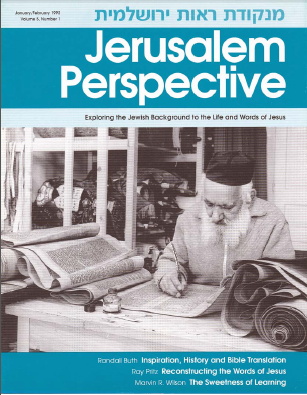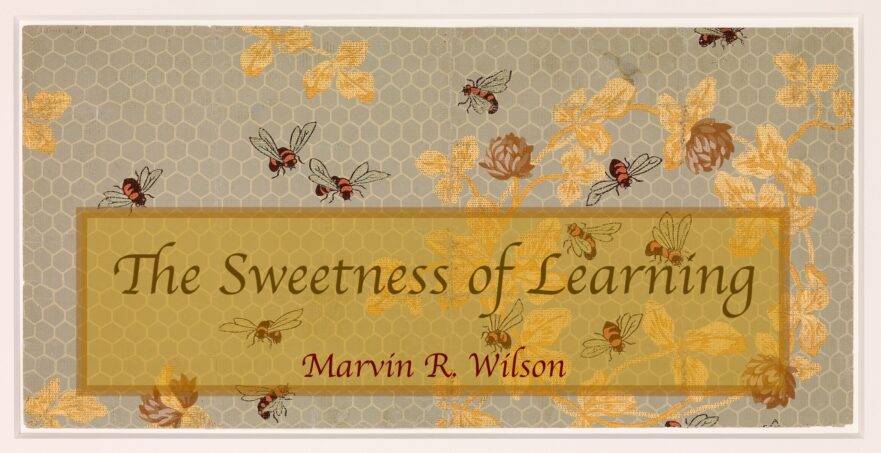How to cite this article: Marvin R. Wilson, “The Sweetness of Learning,” Jerusalem Perspective 36 (1992): 12-13 [https://www.jerusalemperspective.com/2634/].
One of the most frequently quoted biblical texts dealing with education is Proverbs 22:6: “Train a child in the way he should go, and when he is old he will not turn from it.”[1]
The Hebrew verb translated “train” is חָנַךְ (ḥā·NACH). In the Bible this verb and its derivatives occur mainly in contexts suggesting the sense of “to begin, initiate, inaugurate.”[2] For example, the root is used for the formal opening of a building (Solomon’s Temple, 1 Kgs. 8:63), for an initiation gift for an altar (Num. 7:10), and for the time one begins to live in a new house (Deut. 20:5). Since cult sacrifices, consecration rites or prayers were often connected with the inauguration of a structure, the meaning “to dedicate” eventually became extended to ḥā·NACH.
Hanukkah
This rendering, though not inherent in the root itself, accounts for Hanukkah being translated in John 10:22 as “Feast of Dedication.”[3] The New English Bible, following this apparent root-meaning of “begin,” renders Proverbs 22:6: “Start a boy on the right road” (cf. NIV margin, “Start”).
In practice over the centuries, however, it is evident that the Jewish community understood ḥā·NACH as derived from a different root. The verb has customarily been linked with a root meaning “rub the palate or gums”; hence the cognate חֵךְ (ḥēch, “palate,” “roof of the mouth,” “gums”).[4] The Semitic scholar T. H. Gaster states that the original meaning is suggested by the Arab custom of smearing date juice on the gums and palates of newborn children. He also points out that Calvin, the sixteenth-century reformer, indicates that the Jews of his time used to apply honey in a similar way.[5]
Ezekiel’s Scroll
Whatever the etymology of ḥā·NACH, the custom of using honey deserves special mention in any study of Jewish education. Rabbinic tradition informs us that it was the Jewish practice to use honey in a special ceremony on the first day of school. The young child was shown a slate which had written on it the letters of the alphabet, two verses of Scripture (Lev. 1:1, Deut. 33:4), and one other sentence: “The Torah will be my calling.” The teacher next read these words to the child, and the child repeated them back. Then his slate was coated with honey, which he promptly licked off, being reminded of Ezekiel, who said after eating the scroll, “I ate it; and it tasted as sweet as honey in my mouth” (Ezek. 3:3). After this ceremony, the child was given sweet cakes to eat with Bible verses from the Torah written on them.[6]
What is the reason the rabbis tie study and honey together? The answer appears to be due, at least in part, to the linguistic connection they made between the use of ḥēch (palate, gums) and ḥā·NACH (to educate) in certain biblical texts. The rabbis found ḥēch in passages comparing the sweetness of honey to the sweetness of the wisdom and words of God which one spiritually ingests.
Two passages are of special note: “Eat honey, my son, for it is good; honey from the comb is sweet to your taste [ḥēch]. Know also that wisdom is sweet to your soul” (Prov. 24:13-14a); “How sweet are your words to my taste [ḥēch], sweeter than honey to my mouth!” (Ps. 119:103). In addition, the Midrash states that the study of Torah “is compared to milk and honey: just as these are sweet throughout, so are the words of the Torah, as it says, ‘Sweeter also than honey’ [Ps. 19:10]” (Song of Songs Rabbah 1:2, 3). Thus, in the rabbis’ view, education came to involve the task of causing people to enjoy the sweetness of studying divine truth.
One other major point is in order before leaving Proverbs 22:6, “Train a child in the way he should go.” Today, this text is frequently taken to be a command directed to parents, an exhortation for them to instruct their child in Scripture and in the way of godly living. Although the Bible gives a mandate for parental instruction of children,[7] the above proverb does not appear to be one of those texts.
A Child’s Uniqueness
The Hebrew of Proverbs 22:6 is חֲנֹךְ לַנַּעַר עַל פִּי דַרְכּוֹ (ḥā·NOCH la·NA·‘ar ‘al pi dar·KŌ), literally, “Train [start] a child according to his [the child’s] way.” There is a great difference between the training of a child according to the child’s way (i.e., encouraging him to start on the road that is right for him), and training him according to a way chosen, prescribed and imposed by the parents. The former is in keeping with the child’s unique God-given bent, disposition, talents and gifts. It is considerate of the uniqueness of the child; it does not treat all developing personalities the same.
The above translation and interpretation put the onus on the child to choose the right path. It is one thing for a parent to encourage, nurture, guide and inform a child so that the child himself is prepared to choose the path that is right for him; it is something else for a parent to choose that path for the child. This point is the crux to understanding this verse. Again, we must emphasize that this rendering does not negate the parents’ role as teachers of biblical tradition. But it does provide some additional insight into the Hebrew educational process which, parenthetically, corresponds well with certain modern schools of progressive education.
The “training” process begins by seeking to conform the subject matter and teaching methods to the particular personality, needs, grade level and stage in life of the child. (The word na’ar, “child,” in Proverbs 22:6 does not necessarily mean infant or small boy; its more than two hundred occurrences in the Bible reveal a wide range of meanings from childhood to maturity.) Thus, the ability of a “child” to exercise more and more his individual freedom by personal choice—albeit one informed by his parents—is certainly not ruled out.
A Tall Order
By way of application, the above understanding of Proverbs 22:6 places a special responsibility upon every parent. The parent must carefully observe each child and seek to provide opportunities for each child’s creative self-fulfillment. In addition, the parent must be sensitive to the direction in life to which the child would naturally conform, for it is only by walking in that path that the child will come to realize his God-given potential and find his highest fulfillment.
Elizabeth O’Connor effectively grasps how this proverb may apply:
Every child’s life gives forth hints and signs of the way that he is to go. The parent that knows how to mediate, stores these hints and signs away and ponders over them. We are to treasure the intimations of the future that the life of every child gives to us so that, instead of unconsciously putting blocks in his way, we help him to fulfill his destiny. This is not an easy way to follow. Instead of telling our children what they should do and become, we must be humble before their wisdom, believing that in them and not in us is the secret that they need to discover.[8]
This is a tall order. But when parents see that their responsibility is primarily to facilitate, to teach the child to choose the right path, only then will the child be enabled to “fulfill his destiny.” And herein lies an important educational key to making learning a sweet and palatable adventure.


- [1] This article is adapted from Our Father Abraham: Jewish Roots of the Christian Faith (Grand Rapids, MI: William B. Eerdmans Publishing Co., and Dayton, OH: Center for Judaic-Christian Studies, 1989), 291-294, and used by permission. ↩
- [2] See S. C. Reif, “Dedicated to Ḥnkh,” Vetus Testamentum 22 (1972): 495-501. See also Victor P. Hamilton, “ḥānak,” in Theological Wordbook of the Old Testament (ed. R. Laird Harris, et al.; Chicago: Moody Press, 1980), 1:301-302. ↩
- [3] The Hebrew noun חֲנֻכָּה (ḥa·nu·KĀH is properly a rite of inauguration, an event often associated with joyful celebration and sacrifice. Thus the word is most often used in reference to the ceremony of “dedication” or “consecration” of some structure. The origin of the Jewish holiday Hanukkah goes back to the 25th of the month Kislev, 165 B.C., when the Maccabees rededicated the Temple after Antiochus IV Epiphanes had desecrated it. ↩
- [4] Brown, Driver and Briggs, Hebrew and English Lexicon of the Old Testament (London: Oxford University Press, 1907), 335. ↩
- [5] Theodor H. Gaster, Customs and Folkways of Jewish Life (New York: William Sloane Associates Publishers, 1955), 14. ↩
- [6] For further details of this procedure see William Barclay, Educational Ideals in the Ancient World (repr. Grand Rapids, MI: Baker Book House, 1974), 12-13. ↩
- [7] See Deut. 4:9; 6:7; 11:19; Ps. 78:5-6; Prov. 1:8; Eph. 6:4. ↩
- [8] Elizabeth O’Connor, Eighth Day of Creation (Waco, TX: Word Books, 1971), 18. ↩































































































